Problem Framing
Define the problem before you define the solution
The Foundation of all Strategic Account Growth?
Offer Development and Innovation stands as one of the most critical pillars of any successful customer strategy. In today's competitive B2B landscape, the ability to create compelling, differentiated offerings that truly resonate with your key accounts can make the difference between sustained revenue growth and account attrition.
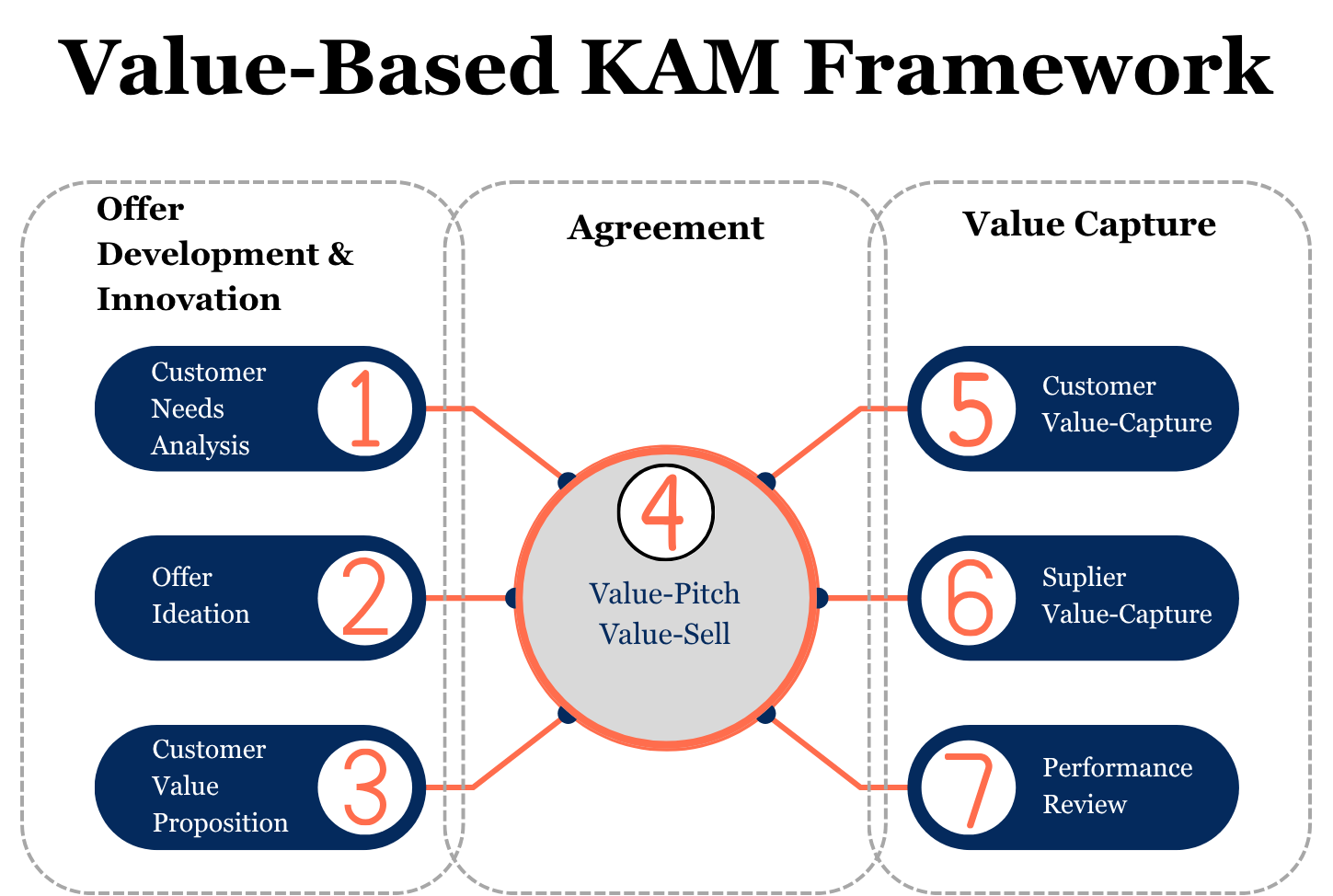
Within the Value-Based Key Account Management Framework, Offer Development and Innovation represents more than just product creation – it's about understanding your customers so deeply that you can anticipate their needs, solve their most pressing challenges, and position your organization as an indispensable strategic partner.
But here's where many account managers and B2B leaders stumble: they rush to develop solutions before truly understanding the problems they're trying to solve. The first and most crucial step in effective Offer Development is Customer Needs Analysis. This process must be broken down into two fundamental activities: Problem Framing and crafting clear Problem Statements.
Within the Value-Based Key Account Management Framework, Offer Development and Innovation represents more than just product creation – it's about understanding your customers so deeply that you can anticipate their needs, solve their most pressing challenges, and position your organisation as an indispensable strategic partner.
Think about your most successful account wins. Chances are, those victories came not from having the flashiest product or the lowest price, but from demonstrating a crystal-clear understanding of your customer's specific challenges and presenting a solution that addressed their root problems, not just surface-level symptoms.
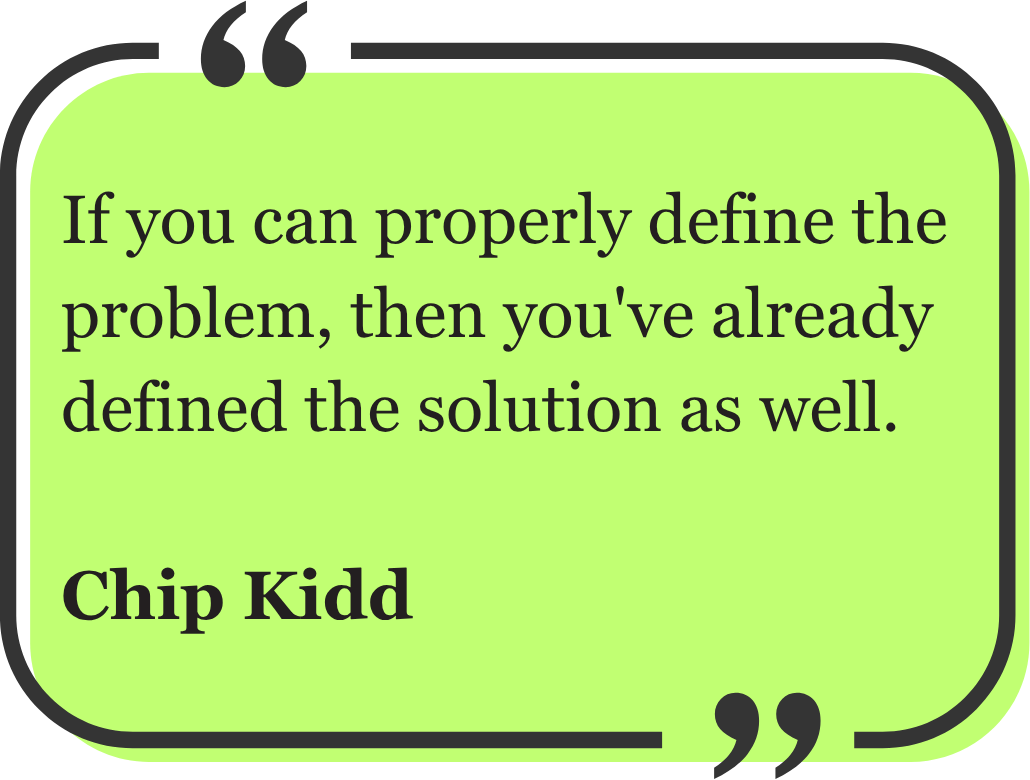
The reality is stark: you cannot provide a meaningful customer solution without a thorough understanding of the problem. Yet every day, sales teams and account managers present solutions to problems they've never properly defined, wonder why their proposals fall flat, and watch competitors win deals with what appeared to be inferior offerings.
What is problem framing?
...and what are problem statements?
Problem framing is defined:
Problem framing is the systematic process of analysing, understanding, and defining a customer's challenge or opportunity to develop an effective solution. For Key Account Managers, this means going beyond what your customer tells you they need and diving deep into why they need it, what's causing the underlying issues, and how solving this problem will impact their business outcomes.
Problem framing in a B2B context involves several critical components:
Contextual Understanding: Understanding not just the immediate challenge, but how it fits within the customer's broader business strategy, industry pressures, and organisational dynamics. A procurement team saying they need "cost reduction" might actually be facing pressure from private equity owners, competitive pricing pressures, or margin compression from supply chain disruptions.
Stakeholder Alignment: Ensuring that you understand how different stakeholders within the account view and experience the problem. The CFO's perspective on budget constraints will differ significantly from the operations director's view of efficiency challenges, yet both perspectives may be addressing the same underlying issue.
Root Cause Analysis: Moving beyond symptoms to identify the fundamental drivers of the customer's challenges. When a customer says they need "better reporting," the real problem might be a lack of real-time visibility into operations, poor data integration across systems, or inadequate decision-making processes.
A problem statement is defined:
A problem statement is a clear, concise articulation of the specific challenge or opportunity you intend to address for your customer. In the B2B environment, an effective problem statement serves as the foundation for proposal development, solution design, and stakeholder communication.
A well-crafted problem statement for Key Account Management should include:
- The specific customer and context (which business unit, market conditions, timing pressures)
- The current state (what's happening now that's problematic)
- The desired future state (what success looks like from the customer's perspective)
- The impact of inaction (what happens if this problem isn't solved)
- Success metrics (how you'll measure whether the problem has been solved)
For example, instead of "Customer needs better technology," a proper problem statement might read: "The procurement department at [Customer Company] is experiencing 23% longer cycle times in vendor selection due to manual approval processes, resulting in $2.3M in delayed project launches annually and creating competitive disadvantage in their core market segments."
What happens when you don't define the problem correctly?
The consequences of poor problem definition in B2B sales and account management are severe and far-reaching. Consider these real-world scenarios that many account managers have experienced:
The Feature-Function Trap
When you don't properly frame the problem, you fall into what we call the "feature-function trap." You end up presenting what your solution does rather than why it matters to the customer's specific situation. Your proposals become generic product descriptions rather than targeted business solutions. Customers can't connect your offering to their real challenges, making price the primary differentiator.
Misaligned Stakeholder Expectations
Without proper problem framing, different stakeholders within your customer organization may have completely different understandings of what you're proposing to solve. The IT director thinks you're addressing system integration issues, while the business leader believes you're solving process efficiency problems. This misalignment leads to internal customer conflicts, delayed decisions, and ultimately lost deals.
Solution Overkill or Underkill
Poor problem definition leads to solutions that are either unnecessarily complex and expensive (because you're solving problems that don't exist) or inadequate (because you've missed critical aspects of the real challenge). Both scenarios damage your credibility and make it difficult to demonstrate ROI.
The Commodity Spiral
Perhaps most dangerously, failing to properly frame problems commoditises your offering. When customers can't see how your solution specifically addresses their unique challenges, they default to comparing features and prices across vendors. You become interchangeable with your competitors, and margins suffer accordingly.
Lost Account Growth Opportunities
In existing accounts, poor problem framing means you miss opportunities for account expansion. You solve the immediate presenting issue but fail to uncover the broader challenges where you could provide additional value. Your account relationships remain transactional rather than strategic.
A simple problem framing/statement model
Based on the principles from the original methodology, here's a practical four-step model specifically designed for Key Account Managers and B2B sales leaders:
The D.E.E.P. Problem Framing Model
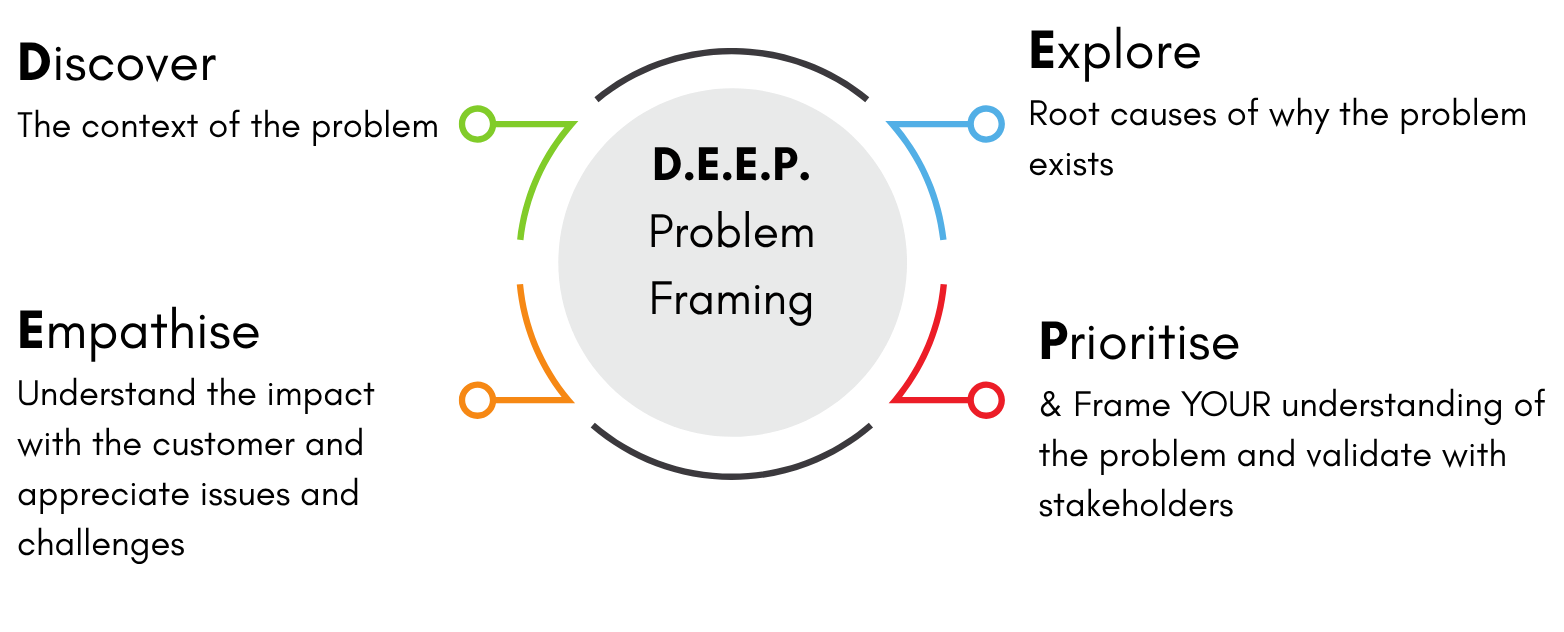
D- Discover..
the Context Begin by mapping the customer's business landscape. What industry pressures are they facing? What are their strategic priorities? Who are the key stakeholders, and what are their individual concerns? Use stakeholder interviews, business research, and account intelligence to build a comprehensive picture of their situation.
Key Questions: What's happening in their industry? What are their top 3 business priorities this year? Who gets promoted or fired based on solving this challenge?
E-Explore..
Root Causes Move beyond the symptoms your customer initially presents. Use the "5 Whys" technique or fishbone analysis to drill down to underlying causes. Often, what customers think they need (better reporting, faster processes, cost reduction) is actually a symptom of deeper organizational, strategic, or operational challenges.
Key Questions: Why is this problem occurring now? What would happen if we solved the symptom but not the root cause? What other areas of the business are affected by this challenge?
E- Empathise..
Empathize with Impact Understand not just what the problem is, but how it affects different stakeholders personally and professionally. How does this challenge impact their daily work, their department's performance, their career advancement, and their company's competitive position?
Key Questions: Who is most affected by this problem? What does success look like from each stakeholder's perspective? What are the personal and professional consequences of inaction?
P- Prioritise
and Frame / Synthesise your discoveries into a clear, compelling problem frame that resonates with all stakeholders. This becomes the foundation for your problem statement and solution development.
The Problem Statement Formula
For B2B contexts, use this structure:
"[Specific Customer Department/Function] is experiencing [Specific Challenge/Gap] which is causing [Quantified Impact] and preventing them from [Strategic Objective]. This problem must be solved by [Timeline] to avoid [Consequence] and achieve [Desired Outcome].
Problem Statement Table
(And Example)
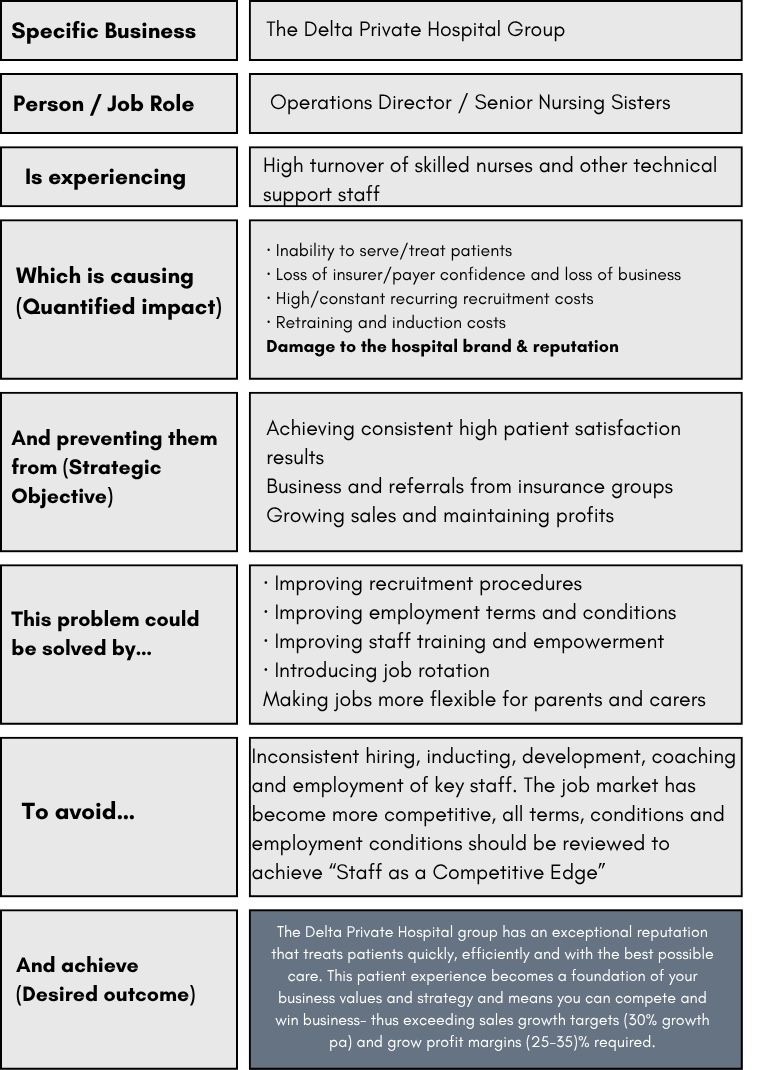
Implementation Process
- Stakeholder Interviews: Conduct structured interviews with 3-5 key stakeholders using the DEEP framework
- Problem Synthesis Workshop: Bring your account team together to synthesise findings and identify patterns
- Problem Statement Development: Craft 2-3 alternative problem statements and test them with friendly stakeholders
- Validation and Refinement: Present your problem framing back to the customer for validation before developing solutions
The impact of getting problem framing right
When Key Account Managers and B2B sales teams master problem framing, the results are transformational across multiple dimensions:
Revenue Impact
Properly framed problems lead to solutions that customers perceive as essential rather than nice-to-have. This shift dramatically improves win rates, shortens sales cycles, and supports premium pricing. Companies that excel at problem framing report 25-40% higher win rates and 15-30% shorter sales cycles compared to feature-focused competitors.
Account Penetration and Growth
When you solve well-framed problems, you don't just win individual deals – you become integral to the customer's success. This positions you for account expansion opportunities, higher customer lifetime value, and increased share of wallet. Customers begin to see you as a strategic partner rather than a vendor.
Competitive Differentiation
Proper problem framing creates natural competitive moats. When you've invested the time to deeply understand and articulate a customer's unique challenges, competitors who haven't made that investment can't easily replicate your insights or match your relevance. You're competing on understanding and relevance rather than features and price.
Customer Relationships and Loyalty
Customers remain loyal to suppliers who demonstrate genuine understanding of their business challenges. When you can articulate their problems better than they can, you build trust and credibility that extends far beyond individual transactions. This emotional connection is crucial for long-term account retention and growth.
Internal Alignment and Efficiency
Precise problem framing aligns your entire team around common objectives. Sales, delivery, customer success, and support teams all understand what success looks like from the customer's perspective. This alignment reduces miscommunications, improves solution quality, and enhances customer satisfaction.
Predictable Revenue Growth
Organisations that systematically apply problem framing to their key accounts report more predictable revenue growth. When you understand the fundamental drivers of your customers' businesses, you can anticipate their needs, prepare solutions in advance, and capture opportunities before competitors even know they exist.
Risk Mitigation
Proper problem framing helps identify potential issues before they become account-threatening problems. When you understand the root causes of your customers' challenges, you can spot early warning signs and proactively address concerns before they impact the relationship.
Your next steps
- Assess your current approach: Review your last three major proposals or account plans. How well did you explain the customer's problem before presenting your solution?
- Choose a pilot account: Select one key account where you can apply the DEEP problem framing model over the next 30 days.
- Practice the problem statement formula: Take a current opportunity and rewrite your understanding of the customer's needs using the structured approach outlined above.
- Stay tuned for the complete framework: The full Value-Based KAM Framework, including comprehensive problem framing methodologies, will provide you with everything you need to transform your account management approach.
Self Diagnostic
Would you benefit from adopting a problem-framing method?
Before implementing any new methodology, it's valuable to assess your current situation. Answer these five questions honestly to determine whether adopting a systematic problem framing approach could significantly impact your account management success:
Question 1:
Solution Clarity When you present solutions to key accounts, do customers immediately understand how your offering addresses their specific business challenges, or do you find yourself having to explain the connection between your product features and their needs?
If you frequently need to explain the relevance, you likely need stronger problem framing.
Question 2:
Stakeholder Alignment In your key accounts, do all decision-makers and influencers share the same understanding of what problem you're solving, or do you encounter situations where different stakeholders seem to be focused on different issues?
If stakeholders often have misaligned expectations, systematic problem framing could eliminate confusion and accelerate decisions.
Question 3:
Competitive Position When competing for opportunities, are your proposals evaluated primarily on business value and strategic fit, or do conversations often default to feature comparisons and price negotiations?
If you're frequently competing on price rather than value, better problem articulation could differentiate your offerings.
Question 4:
Account Growth In your existing key accounts, are you regularly uncovering new opportunities and expanding your footprint, or do relationships tend to remain focused on the original scope of work?
If account growth is limited, deeper problem understanding could reveal expansion opportunities.
Question 5:
Customer Feedback When customers describe your organization to others, do they typically highlight how well you understand their business and solve their challenges, or do they focus mainly on your products, services, or pricing?
If customers don't spontaneously mention your business understanding, enhanced problem framing could strengthen your strategic positioning.
Scoring Your Results:
- 4-5 areas needing improvement: Implementing systematic problem framing could significantly transform your account management effectiveness and revenue outcomes.
- 2-3 areas needing improvement: Targeted application of problem framing methods would likely deliver meaningful improvements in specific accounts or situations.
- 0-1 areas needing improvement: You may already be applying strong problem framing instinctively, but formalising your approach could help you scale these practices across your entire account portfolio.
Remember: In a world where customers have unlimited access to information about products and services, your ability to understand and solve their problems better than anyone else is your most sustainable competitive advantage. Master problem framing, and you master the foundation of strategic account success.
The question isn't whether you can afford to invest time in proper problem framing – it's whether you can afford not to. Your key accounts, your revenue targets, and your career advancement depend on getting this right.
Next steps
If you liked this article or would like to make comments, please get in touch with me.
[email protected]
And if you would like to work with me for coaching and training around Value-Based KAM and Offer Development & Innovation for you/your team, visit the website and get in touch!
 |
Coaching Value Matters provides advice, coaching and training support for B2B suppliers. We specialise in Key Account Management, Offer Developmen... www.value-matters.net |


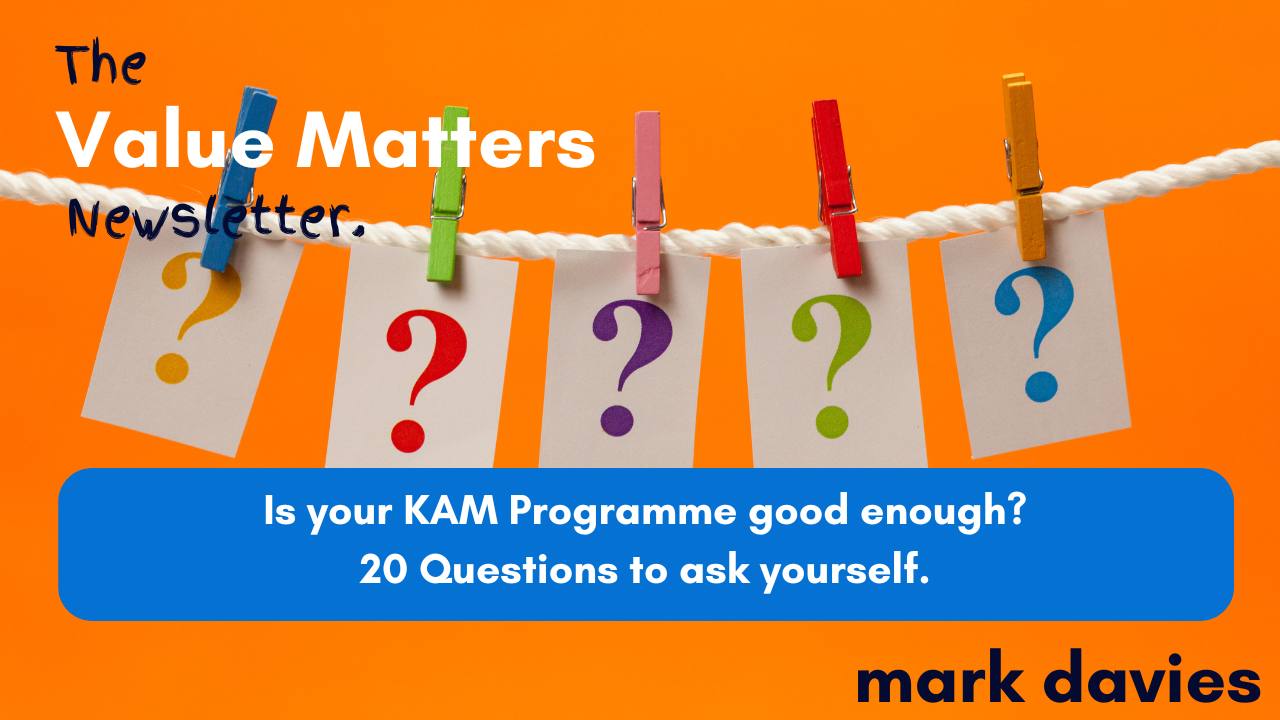



Responses